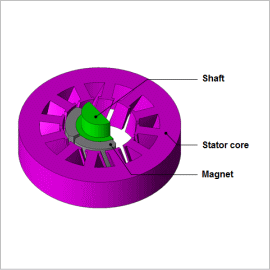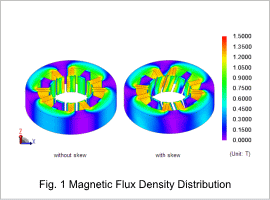*Please prepare a license ID and password for the license administrator.
*It is different from the service for JMAG WEB MEMBER (free membership). Please be careful.
Overview

Reductions in vibration and noise are being sought after because they are a cause of torque variations in motors, and demands for reduction are particularly strong with motors that are used in machine tools and power steering. Cogging torque, which is a torque variation that is produced when there is no current, is generated because the electromagnetic force, which is produced in the gap, changes in relation to the rotor’s rotation, making it necessary to apply skew to the stator and rotor and improvise with the magnet and stator’s geometry in order to limit said variations in electromagnetic force as a countermeasure for reducing the torque variations. When applying skew, force in the thrust direction is produced in exchange for a reduction in the cogging torque, meaning that there is the disadvantage of producing eddy currents from the magnetic flux that links in the lamination direction.
Consequently, in order to accurately evaluate a motor that has skew applied, one needs a magnetic field analysis simulation that uses the finite element method (FEM), which can account for a detailed 3D geometry, instead of studies that use the magnetic circuit method or a 2D magnetic field analysis.
This note presents the use of magnetic field analysis to evaluate the cogging torque of an SPM motor with a skewed stator.
Consequently, in order to accurately evaluate a motor that has skew applied, one needs a magnetic field analysis simulation that uses the finite element method (FEM), which can account for a detailed 3D geometry, instead of studies that use the magnetic circuit method or a 2D magnetic field analysis.
This note presents the use of magnetic field analysis to evaluate the cogging torque of an SPM motor with a skewed stator.
Magnetic Flux Density Distribution
Fig. 1 shows the magnetic flux density distribution of the stator core, and fig. 2 shows the magnetic flux density waveform in the gap. The magnetic flux density waveform is the average of the three points that are indicated on the line in the axial direction shown in fig. 2. As shown in Fig 1, magnetic circuit changes with the application of the skew. Applying skew also deviates the phases of the magnetic flux density waveforms at the three points. Therefore, the variation in the average magnetic flux density waveform is smaller as shown in fig. 2, so the cogging torque may be reduced.


Cogging Torque

Fig. 3 shows the cogging torque waveform of the SPM motor with the skewed stator and with the non-skewed stator. The peak value of cogging torque of the skewed stator is reduced by about 60 percent compared with that of the non-skewed stator.


